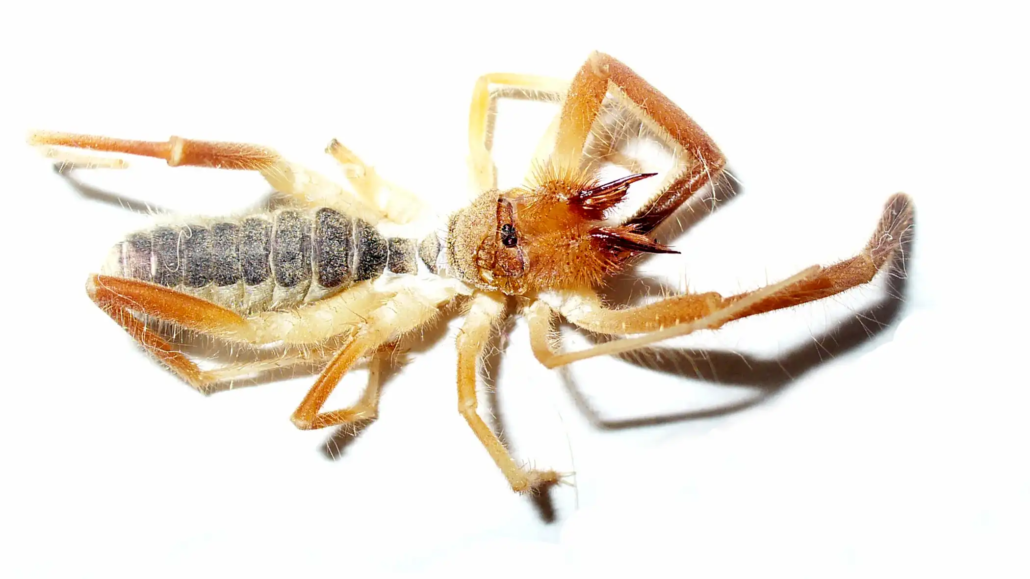The Camel Spider: Screams and Runs 30mph
A camel spider can run at 30 mph and have a terrifying scream while running! At least, that is what urban legend and popular myths would have you believe. The truth is that a camel spider can only run about 10 mph. Camel spiders can get up to 6 inches long and are nocturnal creatures (prefer the night).
This arachnid, scientifically known as Solifugae but commonly referred to as sun spiders or wind scorpions, presents a riveting blend of complexity and diversity.
Appearance and Physical Features: An Astonishing Sight
Around 50 species of camel spiders are found in the southwest US and about 240 in southern Africa. The name ‘camel spiders’ is simply because they are found in the desert. A Camel spider is also known as a wind scorpion, sun spider, and wind spider.
This spider will dig holes and burrow where they spend time during the day. Because the camel spider possesses no venom and is not poisonous and must rely on other assets, such as their force and speed.
Found predominantly in arid regions and deserts across the globe, it boasts a formidable physical appearance that commands attention.
The camel spider is a sight to behold, measuring approximately 6 inches in length, including its spindly, elongated legs. Its robust jaws, large pedipalps, and distinctive chelicerae endow it with menace and intrigue.
Habitat and Distribution: Surviving the Arid Expanse
Adapted to thrive in the barren realms of desert life, the camel spider stakes its claim in the Middle East, North Africa, and parts of the United States. These arid landscapes provide the perfect backdrop for their existence.
Inhabiting sandy or rocky terrains, these nocturnal beings possess an uncanny ability to camouflage themselves amidst their surroundings. Burrowing with finesse, they find solace in the shelter of their burrows, evading the scorching heat that engulfs the daytime desert.
Behavior and Diet: A World of Swift Predation
Step into the realm of the camel spider’s behavioral prowess, where the art of predation takes center stage. These creatures boast astonishing hunting capabilities, propelled by their insatiable appetite and lightning-fast movements.
Swift and agile, they maneuver through their habitat with exceptional agility. Contrary to popular misconceptions, their venom poses no significant threat to humans, debunking the myths surrounding them.
Their voracious diet consists of insects, spiders, small rodents, and even their own kind, showcasing an unyielding hunger for survival. With astonishing speeds reaching up to 10 miles per hour, their prey becomes a mere blip, conquered in the blink of an eye.
Life Cycle and Reproduction: Nature’s Intricate Dance
The life cycle unfurls in captivating ways within the camel spider’s existence. It commences with the female diligently laying her eggs, meticulously burying them within the protective embrace of the sandy terrain.
As life emerges from the eggs, the young spiderlings undergo several molting stages, gradually inching closer to their eventual adulthood. In courtship, the male camel spider unveils an intricate dance, a performance designed to captivate and impress the female.
Once the courtship is complete, the female carries the fertilized eggs with the utmost care until their hatching, a testament to the remarkable display of parental devotion.
Debunking Myths: Unmasking Reality
It is time to separate truth from the web of fiction that enshrouds the camel spider. Over the years, countless myths and urban legends have cast this creature in a terrifying light, depicting it as a fearsome beast relentlessly attacking humans.
Camel Spiders can jump 4 or more feet into the air, eat the stomachs out of camels, and can grow to be the size of a dinner plate – again, another myth of which none are true.
What spooks so many people is that the camel spider seeks out shadows, so if your walking (and even running), the camel spider will actually follow your shadow! This leads to people imagining that the spider is screaming while chasing them!
Because they run so fast and stay in your shadow, you might think they are chasing you but in fact, they are simply staying out of the light.
The next time you are walking and notice a massive spider following you, don’t get to excited, it’s likely your standard camel spider seeking shelter.
Sun Spiders are not Considered Dangerous
The camel spider is not dangerous and typically does not bite humans unless it is on accident or they feel threatened as is the case with other spiders.
